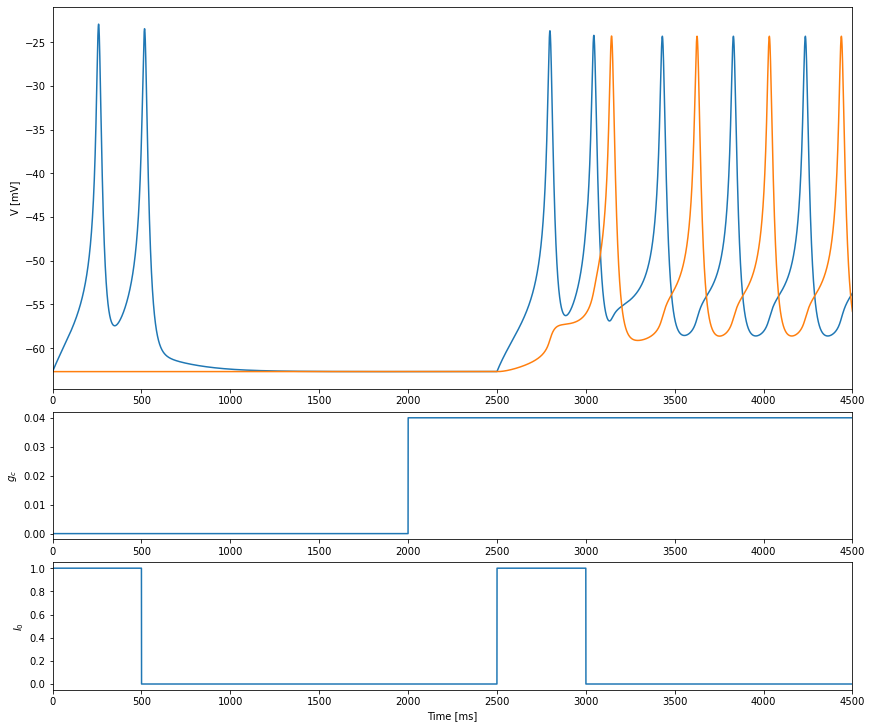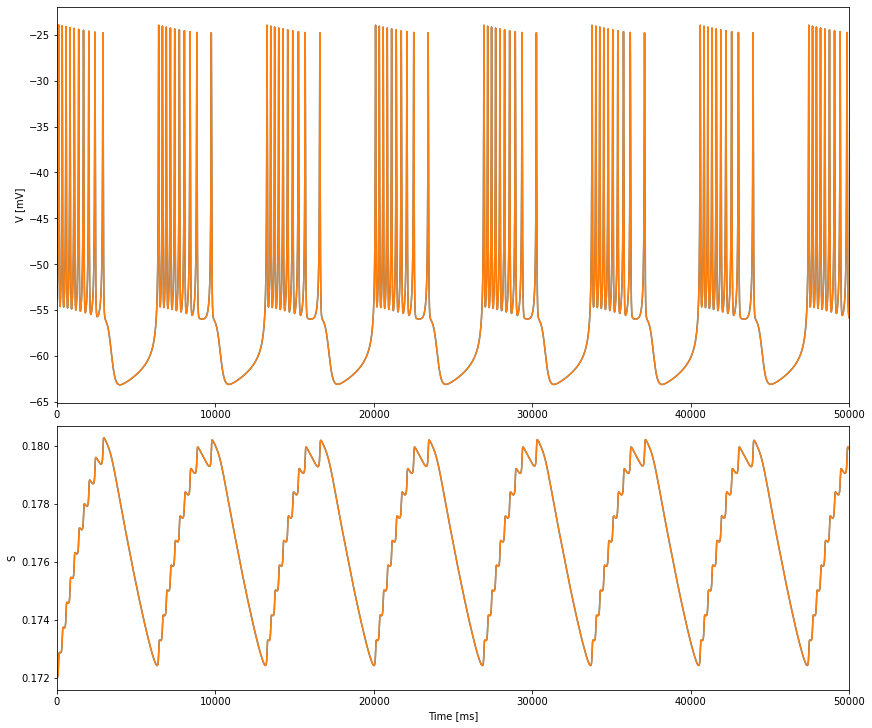(Sherman & Rinzel, 1992) Gap junction leads to anti-synchronization
Implementation of the paper:
Sherman, A., & Rinzel, J. (1992). Rhythmogenic effects of weak electrotonic coupling in neuronal models. Proceedings of the National Academy of Sciences, 89(6), 2471-2474.
Author: Chaoming Wang
[1]:
import brainpy as bp
import brainpy.math as bm
bp.math.set_platform('cpu')
[2]:
import matplotlib.pyplot as plt
Fig 1: weakly coupled cells can oscillate antiphase
The “square-wave burster” model is given by:
where
where
At t = 0.5 s the junctional-coupling conductance, \(g_c\), is raised to 0.08, and a small symmetry-breaking perturbation (0.3 mV) is applied to one of the cells. This destabilizes the single-cell oscillation and leads to an antiphase oscillation. At t = 5.5 s the single-cell behavior is restored by increasing \(g_c\) to 0.24; alternatively, one could set \(g_c\) to 0, but then the two cells would not be in-phase.
[3]:
lambda_ = 0.8
V_m = -20
theta_m = 12
V_n = -17
theta_n = 5.6
V_ca = 25
V_K = -75
tau = 20
g_ca = 3.6
g_K = 10
g_s = 4
[4]:
class Model1(bp.DynamicalSystem):
def __init__(self, method='exp_auto'):
super(Model1, self).__init__()
# parameters
self.gc = bm.Variable(bm.zeros(1))
self.I = bm.Variable(bm.zeros(2))
self.S = 0.15
# variables
self.V = bm.Variable(bm.zeros(2))
self.n = bm.Variable(bm.zeros(2))
# integral
self.integral = bp.odeint(bp.JointEq([self.dV, self.dn]), method=method)
def dV(self, V, t, n):
I_in = g_ca / (1 + bp.math.exp((V_m - V) / theta_m)) * (V - V_ca)
I_out = g_K * n * (V - V_K)
Is = g_s * self.S * (V - V_K)
Ij = self.gc * bm.array([V[0] - V[1], V[1] - V[0]])
dV = (- I_in - I_out - Is - Ij + self.I) / tau
return dV
def dn(self, n, t, V):
n_inf = 1 / (1 + bp.math.exp((V_n - V) / theta_n))
dn = lambda_ * (n_inf - n) / tau
return dn
def update(self, tdi):
V, n = self.integral(self.V, self.n, tdi.t, tdi.dt)
self.V.value = V
self.n.value = n
[5]:
def run_and_plot1(model, duration, inputs=None, plot_duration=None):
runner = bp.dyn.DSRunner(model, inputs=inputs, monitors=['V', 'n', 'gc', 'I'])
runner.run(duration)
fig, gs = bp.visualize.get_figure(5, 1, 2, 12)
plot_duration = (0, duration) if plot_duration is None else plot_duration
fig.add_subplot(gs[0:3, 0])
plt.plot(runner.mon.ts, runner.mon.V)
plt.ylabel('V [mV]')
plt.xlim(*plot_duration)
fig.add_subplot(gs[3, 0])
plt.plot(runner.mon.ts, runner.mon.gc)
plt.ylabel(r'$g_c$')
plt.xlim(*plot_duration)
fig.add_subplot(gs[4, 0])
plt.plot(runner.mon.ts, runner.mon.I[:, 0])
plt.ylabel(r'$I_0$')
plt.xlim(*plot_duration)
plt.xlabel('Time [ms]')
plt.show()
[6]:
model = Model1()
model.S = 0.15
model.V[:] = -55.
model.n[:] = 1 / (1 + bm.exp((V_n - model.V) / theta_n))
[7]:
gc = bp.inputs.section_input(values=[0., 0.0, 0.24], durations=[500, 5000, 1500])
Is = bp.inputs.section_input(values=[0., bm.array([0.3, 0.])], durations=[500., 6500.])
run_and_plot1(model, duration=7000, inputs=[('gc', gc, 'iter', '='),
('I', Is, 'iter', '=')])

Fig 2: weak coupling can convert excitable cells into spikers
Cells are initially uncoupled and at rest, but one cell has a current of strength 1.0 injected for 0.5 s, resulting in two spikes. Spiking ends when the current stimulus is removed. The unstimulated cell remains at rest. At t = 2 s, \(g_c\) is increased to 0.04. This does not prevent the stimulated cell from remaining at rest, but the system is now bistable and the rest state coexists with an antiphase oscillation. A second identical current stimulus draws both cells near enough to the oscillatory solution so that they continue to oscillate after the stimulus terminates.
[8]:
model = Model1()
model.S = 0.177
model.V[:] = -62.69
model.n[:] = 1 / (1 + bm.exp((V_n - model.V) / theta_n))
[9]:
gc = bp.inputs.section_input(values=[0, 0.04], durations=[2000, 2500])
Is = bp.inputs.section_input(values=[bm.array([1., 0.]), 0., bm.array([1., 0.]), 0.],
durations=[500, 2000, 500, 1500])
run_and_plot1(model, 4500, inputs=[('gc', gc, 'iter', '='),
('I', Is, 'iter', '=')])

Fig 3: weak coupling can increase the period of bursting
We consider cells with endogenous bursting properties. Now \(S\) is a slow dynamic variable, satisfying
with \(\tau_S \gg \tau\).
[10]:
tau_S = 35 * 1e3 # ms
V_S = -38 # mV
theta_S = 10 # mV
[11]:
class Model2(bp.DynamicalSystem):
def __init__(self, method='exp_auto'):
super(Model2, self).__init__()
# parameters
self.lambda_ = 0.1
self.gc = bm.Variable(bm.zeros(1))
self.I = bm.Variable(bm.zeros(2))
# variables
self.V = bm.Variable(bm.zeros(2))
self.n = bm.Variable(bm.zeros(2))
self.S = bm.Variable(bm.zeros(2))
# integral
self.integral = bp.odeint(bp.JointEq([self.dV, self.dn, self.dS]), method=method)
def dV(self, V, t, n, S):
I_in = g_ca / (1 + bm.exp((V_m - V) / theta_m)) * (V - V_ca)
I_out = g_K * n * (V - V_K)
Is = g_s * S * (V - V_K)
Ij = self.gc * bm.array([V[0] - V[1], V[1] - V[0]])
dV = (- I_in - I_out - Is - Ij + self.I) / tau
return dV
def dn(self, n, t, V):
n_inf = 1 / (1 + bm.exp((V_n - V) / theta_n))
dn = self.lambda_ * (n_inf - n) / tau
return dn
def dS(self, S, t, V):
S_inf = 1 / (1 + bm.exp((V_S - V) / theta_S))
dS = (S_inf - S) / tau_S
return dS
def update(self, tdi):
V, n, S = self.integral(self.V, self.n, self.S, tdi.t, dt=tdi.dt)
self.V.value = V
self.n.value = n
self.S.value = S
[12]:
def run_and_plot2(model, duration, inputs=None, plot_duration=None):
runner = bp.dyn.DSRunner(model, inputs=inputs, monitors=['V', 'S'])
runner.run(duration)
fig, gs = bp.visualize.get_figure(5, 1, 2, 12)
plot_duration = (0, duration) if plot_duration is None else plot_duration
fig.add_subplot(gs[0:3, 0])
plt.plot(runner.mon.ts, runner.mon.V)
plt.ylabel('V [mV]')
plt.xlim(*plot_duration)
fig.add_subplot(gs[3:, 0])
plt.plot(runner.mon.ts, runner.mon.S)
plt.ylabel('S')
plt.xlim(*plot_duration)
plt.xlabel('Time [ms]')
plt.show()
With \(\lambda = 0.9\), an isolated cell alternates periodically between a depolarized spiking phase and a hyperpolarized silent phase.
[13]:
model = Model2()
model.lambda_ = 0.9
model.S[:] = 0.172
model.V[:] = V_S - theta_S * bm.log(1 / model.S - 1)
model.n[:] = 1 / (1 + bm.exp((V_n - model.V) / theta_n))
model.gc[:] = 0.
model.I[:] = 0.
[14]:
run_and_plot2(model, 50 * 1e3)

When two identical bursters are coupled with \(g_c = 0.06\) and started in-phase, they initially follow the single-cell bursting solution. This behavior is unstable, however, and a new stable burst pattern emerges during the second burst with smaller amplitude, higher frequency, antiphase spikes.
[15]:
model = Model2(method='exp_auto')
model.lambda_ = 0.9
model.S[:] = 0.172
model.V[:] = V_S - theta_S * bm.log(1 / model.S - 1)
model.n[:] = 1 / (1 + bm.exp((V_n - model.V) / theta_n))
model.gc[:] = 0.06
model.I[:] = 0.
[16]:
run_and_plot2(model, 50 * 1e3)

[17]:
model = Model2(method='exp_auto')
model.lambda_ = 0.9
model.S[:] = 0.172
model.V[:] = V_S - theta_S * bm.log(1 / model.S - 1)
model.n[:] = 1 / (1 + bm.exp((V_n - model.V) / theta_n))
model.gc[:] = 0.06
model.I[:] = 0.
run_and_plot2(model, 4 * 1e3)

Fig 4: weak coupling can convert spikers to bursters
Parameters are the same as in Fig. 3, except \(\lambda = 0.8\), resulting in repetitive spiking (beating) instead of bursting. Oscillations in \(S\) are nearly abolished. Two identical cells are started with identical initial conditions (only one shown for clarity). At t = 20 s, \(g_c\) is increased to 0.04 (right arrow) and a small symmetry-breaking perturbation (0.3 mV) is applied to one cell. After a brief transient, the two cells begin to burst in-phase but with antiphase spikes, as in Fig. 3.
[18]:
model = Model2()
model.lambda_ = 0.8
model.S[:] = 0.172
model.V[:] = V_S - theta_S * bm.log(1 / model.S - 1)
model.n[:] = 1 / (1 + bm.exp((V_n - model.V) / theta_n))
model.gc[:] = 0.06
model.I[:] = 0.
[19]:
gc = bp.inputs.section_input(values=[0., 0.04], durations=[20 * 1e3, 30 * 1e3])
Is = bp.inputs.section_input(values=[0., bp.math.array([0.3, 0.])], durations=[20 * 1e3, 30 * 1e3])
run_and_plot2(model, 50 * 1e3, inputs=[('gc', gc, 'iter', '='),
('I', Is, 'iter', '=')])
